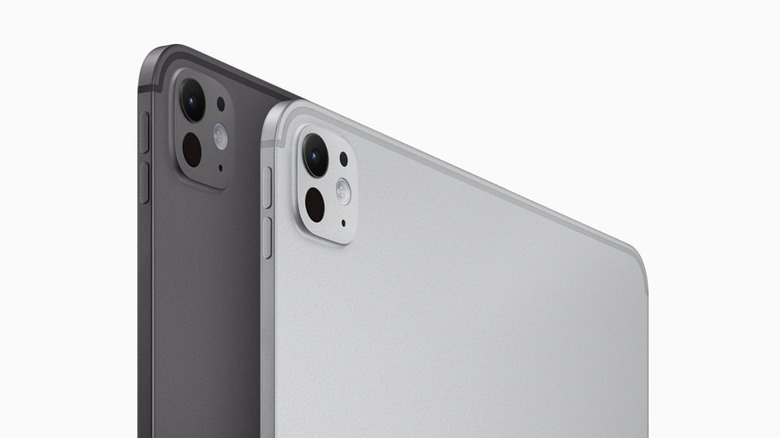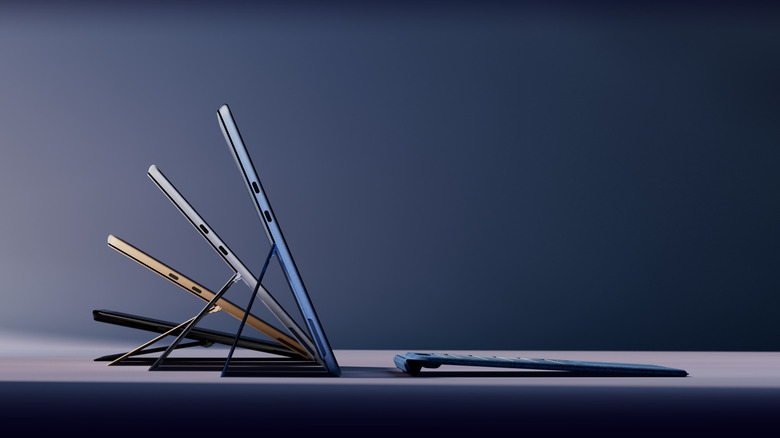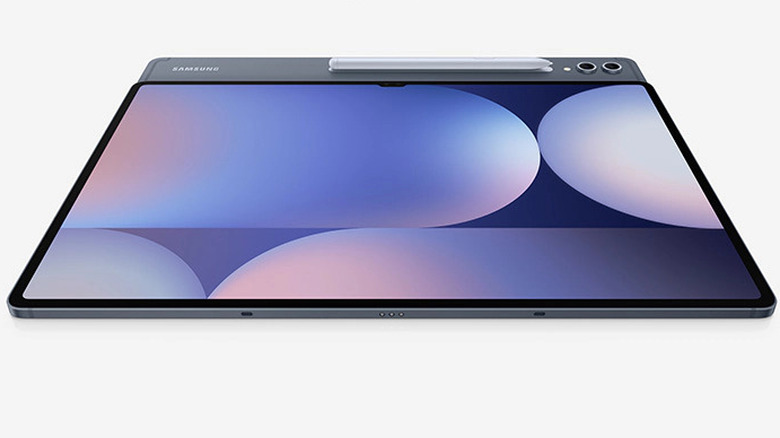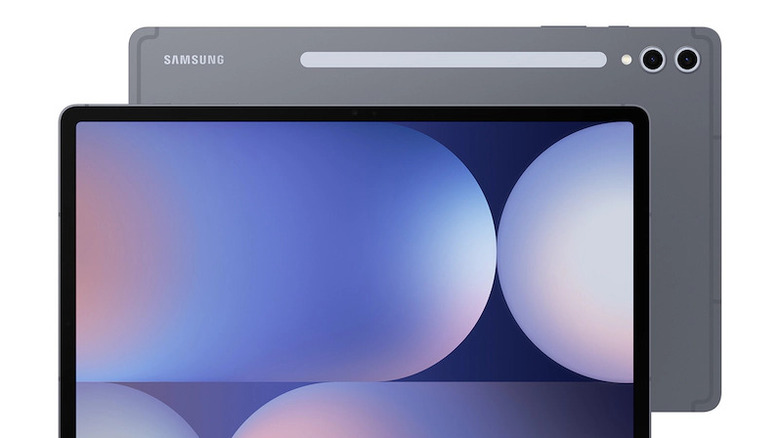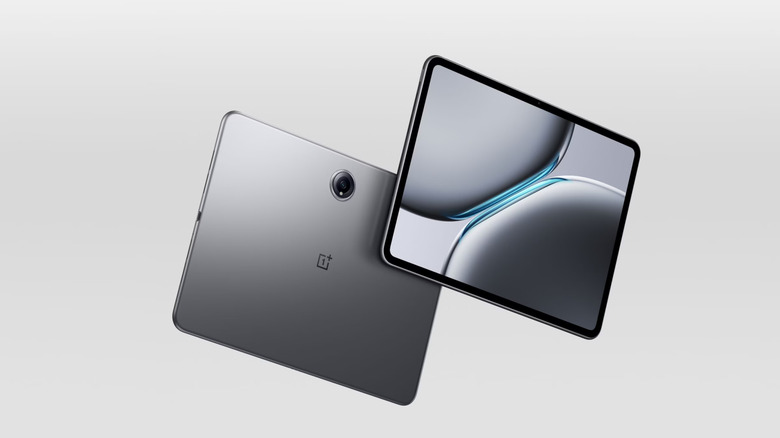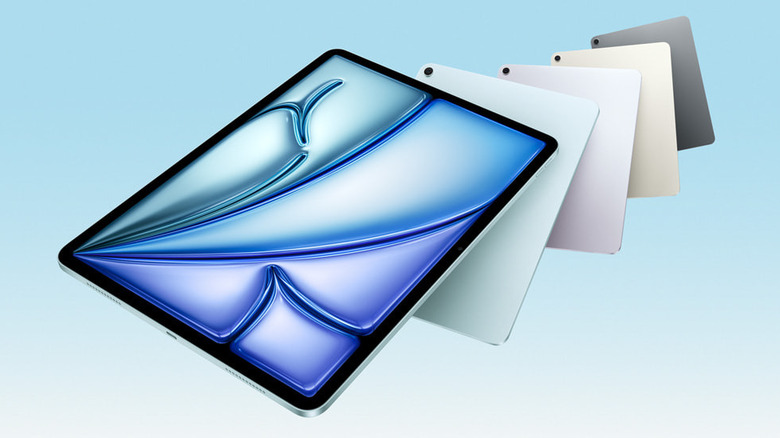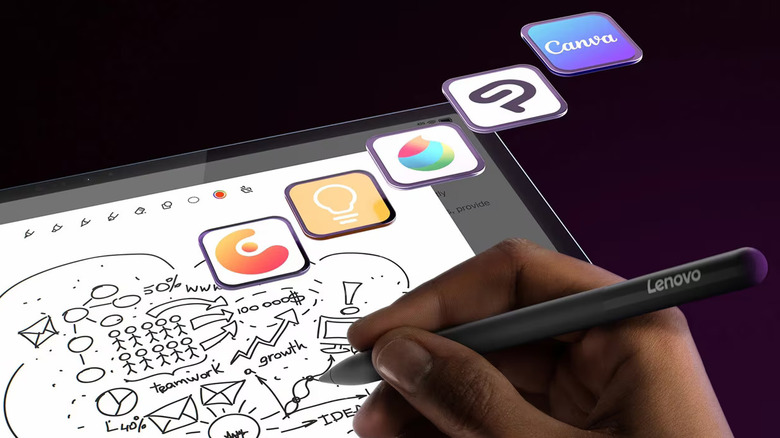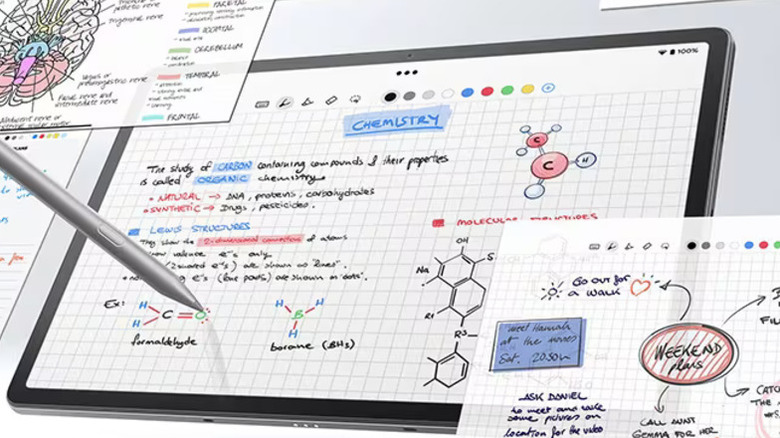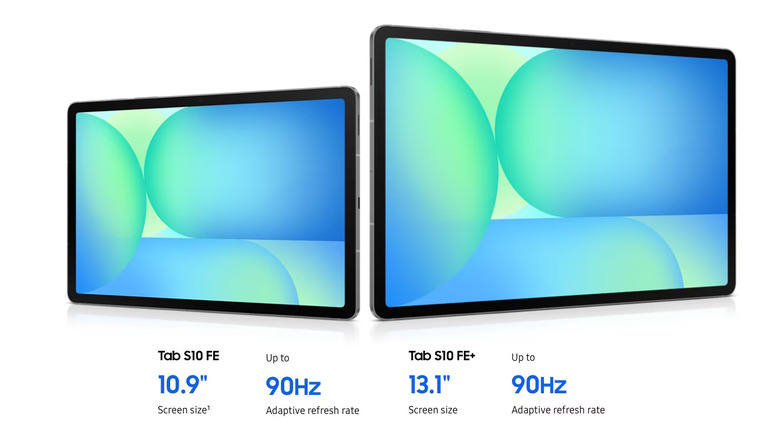10 Of The Best Tablets Over 12 Inches You Can Buy Right Now
We may receive a commission on purchases made from links.
Tablets are slowly growing out of the awkward no-in-between phase and comfortably settling into the widely growing gray area between a smartphone and a laptop. We get it, size really does matter sometimes — especially when your fingers keep smashing up against all the wrong buttons on the screen and your eyes are tired of squinting. For this particular reason, we've rounded up 10 tablets over 12 inches that deliver in size and substance alike.
There's a decent smatter of flagship tablets with excellent performance and premium features, along with a few mid-tier models, that deliver fantastic results and ensure everyone has their pick of the lot. Well-renowned names such as Apple, Samsung, and Lenovo make multiple appearances on the list, while others, such as OnePlus and Xiaomi, hold their own with commendable products. Whether you're a student of the fine arts, a tech-savvy professional, or someone who loves to curl in bed with a big screen and a box of candy, this list of very large tablets is here to help you find your just-right fit.
Apple iPad Pro M4
If you clicked on this article thinking "I want the biggest, baddest tablet money can buy," then you don't need to scroll any further. Kicking off the list is Apple's latest attempt at blurring the line between a tablet and a spaceship (and Slashgear's editors choice): The 13-inch iPad Pro M4 (also available in 11 inches).
Released in 2024, this thing is absurdly lightweight and thin; it's Apple's thinnest product yet with a depth of 5.1 millimeters. Once you get past the stunning build, the second thing that sticks out is the perfectly crisp and vibrant tandem OLED display. With a peak brightness of 1,000 nits as standard and 1,600 nits in high dynamic range-mode, even the movies with a 4.0 on IMDb start looking good. Tucked behind this exterior is the impressive M4 chip that has the entire tech industry wrapped around its little finger: It's extremely powerful, lightning fast, and a massive upgrade from its M2 predecessor (at least on paper). Just don't get too excited unless you're willing to cough up even more money for the 10-core version of the M4 with 16GB of RAM on top of the $1,299 base cost –- features not built-in with the 256GB and 512GB models, both of which sport 8GB RAM and a 9-core CPU. Who needs financial stability anyways?
Microsoft Surface Pro 11
Microsoft hit redemption arc territory with the 11th-gen Surface Pro, which is currently an Amazon's Choice product with a 4.4 rating and stellar reviews. This 2-pound hunk comes in a couple of variants, the cheapest one starting from $1,000 and featuring the Snapdragon X Plus, 16GB RAM, 256GB SSD, and an LCD touchscreen.
Not shabby at all, but if you want to level up with the Snapdragon X Elite, you're looking at a price hike of $500 minimum. In return, you also get the sweet gift of an OLED screen, up to 32GB RAM, and up to 1TB SSD. All of this, however, is without the keyboard; if you were dreaming of a 2-in-1 situation, the "1" costs extra. It's definitely easy on the eyes, especially with color options such as Sapphire and Dune in the mix. The battery life is nothing to sneeze at either, and users are more than satisfied with the speed it delivers. That being said, there's nothing substantial that sets this tablet a notch above the rest. In the end, it's a bit like a designer handbag: Great to look at, pretty popular, functional, and well-made, but a lot more pricey than it needs to be –- money you don't need to be paying unless you're fully committed to that lifestyle.
Samsung Galaxy Tab S10 Ultra
As the name implies, the Samsung Galaxy Tab S10 Ultra is the fanciest kid on the S10 block. It can be found for a couple hundred dollars cheaper (give or take) than the iPad Pro on the Samsung store or Amazon. However, apart from the extra digit slapped on the box, it's pretty much an S9 Ultra in a fresh new outfit; even all of the S9 Ultra's accessories fit onto and work with the S10 Ultra.
With the largest display on our list, this 14.6-inch AMOLED slab dares you to call it portable. It's one of the biggest mainstream tablets right now (along with the S9 Ultra), so it's perfect for anyone who loves a big screen for media consumption, drawing, reading, or impressing a stranger across the café. Samsung's website boasts a 16-hour battery life, but professional and user reviews contradict that with claims of a battery life that's up to 10 hours when in regular use. The S10 Ultra comes with the MediaTek Dimensity 9300+ CPU built to support Samsung's suite of AI tools such as Circle to Search, AI Note Assist, and much more. Sounds good, but here's the tea: It might outpace the Snapdragon in graphics, but falls a little short on power and performance. Not very "Ultra" of them (especially with Apple powering its Pro model with the M4 chip), but it's still pretty solid; especially since it comes with a built-in S Pen.
Samsung Galaxy Tab S10+
A 14.6-inch display isn't everyone's cup of tea. If you fall into that category, you can forego the S10 Ultra and turn to the 12.4-inch Galaxy Tab S10+ instead. While the S9+ was the golden child of Samsung's tablet empire back in 2023, it's a year older and only has a handful of updates left in it, making the S10+ the smarter pick.
The S10 series comes dressed to impress with the IP68 water- and dust-resistance introduced in the S9 series — which isn't traditionally found on other flagship tablets — instantly giving both Samsung options a marginal lead. The S10+ has the same AMOLED 2x display, an S Pen, a 13MP wide-angle lens and 8MP ultra-wide camera on its rear, a 12MP camera on the front, and it's topped off with a fantastic speaker. Throw in the same MediaTek Dimensity CPU as the Ultra and it's clear you're not sacrificing performance in the name of portability. It rivals even some of the best iPads out there, performing better than the iPad Pro M4 in certain cases. With all the same features as the S10 Ultra, Slashgear gives the S10+ an 8/10. Your choice mostly comes down to personal preference: You're either an artist who wants to draw on something as large as a dinner tray, or your only concern is fitting your tablet into your bag. Sometimes, bigger isn't always better, it's just... heavier.
OnePlus Pad 2
Taking over the reins from the original OnePlus Pad released in 2023, the only thing the Pad 2 is second in is the title. From performance to build, the OnePlus Pad 2 serves as a reminder that sequels can be better, with some even crowning it as the best Android tablet out there.
With a Snapdragon 8 Gen 3, 12GB RAM, and OxygenOS, it breezes through everyday tasks, including streaming, browsing, and scrolling into unknown territories. It barely makes the cut for our list with a 12.1-inch LCD display, a unique 7:5 ratio, and 600-nit brightness. These specs, paired with OnePlus's Open Canvas multitasking magic, allow you to simultaneously run three apps without feeling like you need a magnifying glass or medication for a looming migraine. Another notable feature is the tablet's ability to charge from 0% to 100% in 80 minutes (give or take), making for a well-rounded and budget-friendly tablet. It's not as snappy as an iPad and lacks some of Samsung's premium features (including being waterproof), but for just $550 it gives you more than what you're paying for and is more powerful than it looks. The only thing that didn't get the memo is the camera: It's there, it takes pictures, and that's about all the good things you can say about it.
Apple iPad Air M3
If the iPad Pro is the equivalent of a spaceship, the iPad Air M3 is like flying business class with miles: It's much more affordable and definitely better suited for the general public. It's an honorary inclusion for all the users who want something with a bit more muscle than the entry-level iPad, but not so extra it starts demanding an artisanal coffee and a desk of its own; this makes it one of the best tablets for students.
The iPad Air has always been a crowd pleaser and a people's favorite; all of that goodness is now powered by the M3 chip, which Apple claims is nearly twice as fast and gives almost 40% faster graphics performance than the iPad Air M1. It's better suited to support Apple Intelligence and seamlessly incorporate AI-driven features such as Image Wand and Clean Up. Toss in the cute pastel options in both the 11- and 13-inch variants and boom, instant functional slate and fashion accessory. There's no OLED screen like the iPad Pro, but the performance is buttery smooth and the battery life isn't likely to betray you mid-work session. It's not a massive upgrade from its predecessor with the M2 chip, but it looks fancy, works hard, and doesn't drain your pockets.
Lenovo Yoga Tab Plus
Say hello to the new kid on the block eyeing the throne currently occupied by the biggest names in the industry. Not only is it flexing enough specs to go head-to-head with Apple and Samsung's best, it's doing so at a mere $700... with a stylus and keyboard case included. Professional reviews titled it the best tablet of CES 2025, and that's just one of the reasons why.
Starting with the exterior, it comes in two color options (Seashell and Tidal Teal) with a very modern-esque all-metal body, making it relatively heavier than the S10+ and iPad Pro. A 12.7-inch display and 144Hz refresh rate (an upgrade from the Lenovo Tab P12) offer a fast and seamless experience; no OLED screen like the competition, but it gets by pretty well nonetheless. Under the hood, the Lenovo Yoga Tab Plus has an 8-core Qualcomm Snapdragon 8 Gen 3, ensuring adequate power and performance, with reviews confirming solid runtimes and no heating up. The built-in Harman Kardon speakers are just as impressive, and battery life is comparable with the mainstream tablets out there. It's still in its freshman year, but this tablet's already sitting at the cool kids table.
Lenovo Tab P12
Quite unlike the Yoga Tab Plus, the Lenovo Tab P12 is an older, mid-range, 12.7-inch tablet with a better-than-decent roster of specs and features. It's not winning any awards, but it's surprisingly competent.
Sporting an LCD screen with a 2944-by-1840 resolution and Dolby Atmos speakers, it's a little over $300 on Amazon. Much like its successor, the $300 includes the pen and keyboard case, making this the most budget-friendly option on our list. It has fantastic reviews, too; users commend its bright display, sharp resolution, crisp sound system, and top-notch functionality. The Tab P12 has a nice MediaTek Dimensity 7050, which makes moderate gaming and a semi-powerful workload a breeze. However, the battery life is average at best, cellular options have been revoked, and, with a refresh rate of only 60Hz, it falls back in the race with its competitors. Still, for about $300 you get a large, no-nonsense tablet with great reviews from a brand that consistently punches above its price bracket; just like that reliable friend who always brings snacks and is incredibly easy to appreciate.
Xiaomi Redmi Pad Pro
While we're still discussing mid-range tablets, let's talk about a name that doesn't often get invited to the tablet popularity contest: Xiaomi, despite the brand dethroning Apple as the second-largest smartphone manufacturer in the world. The Xiaomi Redmi Pad Pro has the same $300 price tag as Lenovo's mid-range Tab P12 (minus a stylus or folio) and is an Amazon's choice product with a near-perfect 4.9 rating. But how well does it compare to its competition?
The 12.1-inch display features a 600-nit peak brightness and a 120Hz refresh rate — double than that of the Tab P12 — with a QHD+IPS panel, which serves great for multimedia usage. It looks fantastic with its aluminum body, the battery life goes well beyond the 10-hour mark, and the tablet boasts a quad surround sound speaker system. Performance wise, the Snapdragon 7s Gen 2 processor ensures there's no major shortcomings, and professional and user reviews alike are quick to call it one of the best budget tablets. If there's anything to whine about, it's the lack of accessories; Xiaomi giveth, but not without the dollar bills.
Samsung Galaxy Tab S10 FE Plus
Rounding off the lineup is yet another Samsung product in the S10 series: The 13.1-inch Samsung S10 FE+, meant to compete with the new iPad Air. It's the most-recently released product on our list and is available in blue, gray, and silver — very business casual. For the most part, it mostly does what Samsung does best, regardless of model: An S pen is included in the box and we've got IP68 dust- and water-resistance. Relative to the S10 series, this is considered to be the budget-friendlier option out of the other two in our lineup.
For $650, you get 128GB of storage — for $100 more, you get double. You do, unfortunately, lose a few bragging rights along the way to put it in the lower price bracket: No ultra-wide rear camera, LCD panels instead of OLED, and a 90Hz refresh rate. However, it's still larger than the more expensive S10+ and comes with all the AI features. Compared to its popular, almighty predecessor, the S10 FE+ is $50 more expensive but features the same Exynos 1580 chipset. All in all, it's not the most powerful, the biggest, or the flashiest, but it's not trying to be either. We respect that.
How we chose the best tablets over 12 inches
Each of these tablets was chosen with no compromise on the factors that contribute to making a good tablet: Performance, battery life, budget, and overall specs in the competitive tablet market. Slashgear's professional reviews and overall user reviews were also considered, and a wide array of products were chosen to ensure inclusivity. And, if you're not into these big ones, look into the best android tablets you can find under 12 inches instead.

